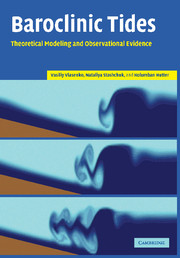Book contents
- Frontmatter
- Contents
- List of tables
- Preface
- Acknowledgements
- List of symbols
- List of abbreviations
- Preamble
- 1 General background
- 2 Linear baroclinic tides over variable bottom topography
- 3 Combined effect of horizontal density gradient and bottom topography on the dynamics of linear baroclinic tides
- 4 Topographic generation of nonlinear baroclinic tides
- 5 Evolutionary stages of baroclinic tides
- 6 Generation mechanism for different background conditions
- 7 Three-dimensional effects of baroclinic tides
- References
- Index
5 - Evolutionary stages of baroclinic tides
Published online by Cambridge University Press: 14 August 2009
- Frontmatter
- Contents
- List of tables
- Preface
- Acknowledgements
- List of symbols
- List of abbreviations
- Preamble
- 1 General background
- 2 Linear baroclinic tides over variable bottom topography
- 3 Combined effect of horizontal density gradient and bottom topography on the dynamics of linear baroclinic tides
- 4 Topographic generation of nonlinear baroclinic tides
- 5 Evolutionary stages of baroclinic tides
- 6 Generation mechanism for different background conditions
- 7 Three-dimensional effects of baroclinic tides
- References
- Index
Summary
In this chapter we consider the evolutionary stage of baroclinic tides, i.e. the behavior of the tidally generated internal waves beyond the source of generation. During propagation, the long baroclinic tidal waves which are radiated from this area of generation – usually bottom features – are subjected to nonlinear effects, as shown in Chapter 4. If the nonlinearity is sufficiently strong, these waves are usually transformed into a sequence of solitary internal waves or wave trains. So, we shall now concentrate on the dynamic structure of solitary internal waves. First, we will give a brief summary of a number of analytical theories and consider the stationary solutions of weakly nonlinear equations. Then, we will move on to consider strong solitary internal waves; even though any analytical theory fails to describe their structure and dynamics, nevertheless they are a common feature of the real ocean. Using several numerical procedures, the governing equations can be handled and a physical understanding can be extracted. Using this approach, we will study the spatial–temporal structure of strong waves and indicate their differences from strict analytical solutions of equations describing weaker nonlinear interactions. Finally, we will present the wave transformation appropriate over variable bottom topography that includes strong effects such as wave overturning and breaking.
- Type
- Chapter
- Information
- Baroclinic TidesTheoretical Modeling and Observational Evidence, pp. 182 - 259Publisher: Cambridge University PressPrint publication year: 2005



